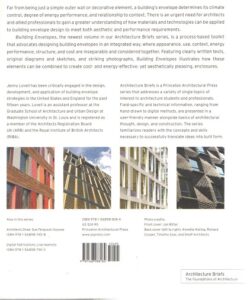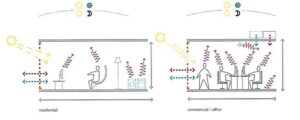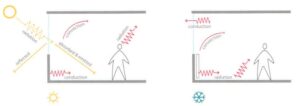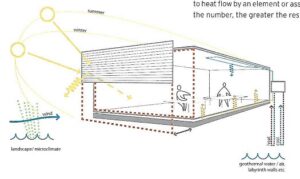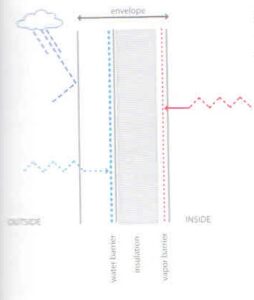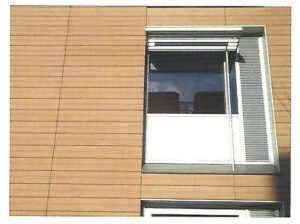Building Envelopes: An Integrated Approach
Heat: Gain and Loss
By Jenny Lovell
Foreword
By Bob Allies
Allies and Morrison, London
The last century saw a radical change in the nature of the building envelope. Rather than being considered as part of the structure – a single, homogeneous plane perforated by openings – it began to be conceived instead as a separate layer that, relieved of any structural responsibility, could fulfil the sole function of protecting the interior of the building from the vagaries of the outside world.
At first sight, this separation of a buildings structure from its envelope might be expected to be liberating, freeing the contemporary architect to invent new and radical solutions to the problems of creating building enclosure. But the reality, as this book makes clear, is at once more complex and more interesting. The design of the building envelope has to address a wide spectrum of issues, ranging from the technical performance of the individual materials and the nature of their assembly to the visual appearance and propriety of the resulting building form.
In setting down and explaining these various issues in this book, Jenny Lovell draws them fully into the design process, offering the prospect of generating architectural form and meaning directly from their resolution. For this to happen, an approach is required that fuses practical considerations of how a building works – how it maintains the physical comfort of its occupants – with aesthetic, or cultural, considerations of how a building looks – how it is assimilated into its context and what it represents. “Poetic sensibility integrated with pragmatic application,” as Lovell describes it.
When addressing these issues in the past, an architect would, conventionally, have interpreted his obligations as being on the one hand to the client – for whom the building was being provided – and, on the other, to his own professional reputation. Today, however, this is no longer enough. The threat of climate change, and the growing recognition of the need to combat it, has given architects a fundamental obligation to design buildings that consume a minimum amount of resources in their production as well as in their long-term operation and maintenance.
Inventiveness and ingenuity are therefore critical to the design of building envelopes in the future, and the complete integration of the skills and experience of all members of the design team will be fundamental to this process. The innovation needed is of a particular kind: it is not introduced in order to make one building look different from another, but is aimed at the development of new models and archetypes that have widespread relevance and application.
This requires a more thorough understanding of the issues that are to be addressed, more active research into the solutions that might be adopted, and more imaginative speculations as to how these problems might be solved. Because of the nature of the discipline, it also means architects must be capable of explain these issues to their client, thereby eliciting their support for the inevitable additional investment that will be required.
What this book also advocates, however, is that the architect should engage with the particularities of his or her specific project – the exact nature of the climate that it has to moderate, the precise type of activity it has to accommodate, and the context to which it has to contribute – to develop buildings of originality and imagination, building that go beyond the adoption of the run-of-the-mill solution.
A buildings envelope forms the critical interface between its interior life and the environment of the external world. Its design is therefore at the heart of the architectural process, a process that will be both informed and stimulated by the guidance that this book provides.
Heat: Gain and Loss
Just as our skin is a zone of thermal exchange for our bodies, so too is an envelope for a building. Cooling and space heating accounts for approximately 50 percent of energy use in commercial buildings in the United States and internal environmental systems invariably operate in spite of, rather than assisted by, building envelope performance.
Heat: Problems-1
Modern buildings envelopes, enabled by steel and concrete-frame construction, are lightweight and incorporate large areas of glazing. Compared with load-bearing masonry walls, unitized and curtain wall systems have a low thermal storage capacity and rely on layers of insulation or glass to resist heat loss.
1-Heat: Problems
This diagram identifies the differences associated with heat for residential buildings (left) and commercial/office buildings (right). Both are dependent on the time of day and season as well as building construction type, floor-to-floor height, and plan depth. However, office spaces are likely to have more occupants as well as equipment and will therefore need to address heat gain (especially in ht e afternoons) as a primary concern.
Our building envelopes are leaky, and they too freely transfer hot or cold air to the external environment, wasting energy. Inconsistent air barriers, untested for air leakage levels, are a high source of energy waste in buildings. Large expanses of poorly specified glass will transfer solar heat gain to the interior of a building, while badly detailed and constructed walls will transfer heat to a cold exterior. Building codes are based on meting specified minimums on paper, instead of on-site testing. Buildings are not required to meet maximum best-practice performance through integrated systems.
The desire for transparency in our buildings has been aligned with the area of glazing often used in them, but 100 percent glazing is not required in order to achieve sufficient daylight levels, and brings with it serious challenges from solar heat gain and loss to the outside.
Heat: Principles-2
Heat flow is the physical process by which energy moves from a hot zone or body to a cold one through one of three mechanisms: radiation, convection, or conduction. When it is cold outside, internal heat will try to flow out through a building’s envelope, and vice versa when it is hot outside.
2-Heat: Principles
Heat flow through a building envelope into an enclosed space will vary depending on climate, season, daily high and low temperatures, orientation, and solar exposure. Thermal energy moves from hot to cold through radiation, convection, and/or conduction.
Internal heat gains depend on the functions, program, and equipment of the space enclosed. External heat gains depend on location in the world (climate and microclimate), solar intensity, and building adjacencies. The combined maximum internal and external heat gains and losses represent a peak loading. It is this peak load against which mechanical systems are designed. If the load can be spread over a period of time, peak loads are reduced and so are mechanical system specifications and, ultimately, energyuse. If the peaks and troughs can be reduced or flattened out at points of peak load, less energy will be needed to maintain comfort levels in a building.
3-Heat: Principles
A heat-curve diagram, originally derived from ASHRAE data, indicates the temperature difference through both light and heavy envelopes for a west-facing façade in St. Louis, Missouri. The heavy wall’s line indicates how the peak load of the interior has been mitigated, thereby loering the peak design loads for its building’s systems.
Mass provides a thermal lag (heat capacity and conductivity over time). Concrete, for example, will absorb heat and release it once there is a temperature differential. Provided that the surface is in contact with a space, this principle of thermal lag can be applied both to delay heat transfer, reducing peak loads on a space, and to reuse the absorbed heat or coolness for an overall system advantage.
A material with trapped layers or pockets of air will have a higher resistance to heat loss than a dense material. Therefore, insulation will provide resistance to heat loss through an assembly. A materials U-value (Btu/hr-ft2 degree F) is the rate of heat flow lost through an element or assembly through conduction for a unit of temperature difference-the greater the number, the greater the heat loss. An R-value (ft2-degree F/Btu) indicates the resistance to heat flo by an element or assembly – the greater the number, the greater the resistance (U=1/R).
Heat: Potential-4
4-Heat: Potential
The depth of a buildings envelope and shading devices (as depicted as part of the enevelope system on this diagram) can be exploited to address or utilize potential solar heat gain as well as maximize daylighting potential. In addition to direct systems, integrated building envelope design can coordinate with engineered alternative sources of heating and cooling (such as geothermal heating or belowground labyrinth walls to cool intake air), the site’s landscape strategy and specific microclimate, and their effect on a building’s internal environment as a holistic approach.
Wherever possible, a building’s orientation should be optimized to reduce or increase solar heat gains as required. East and west elevations are the hardest to control in terms of heat gains, since the sun is at a lower angle of incidence to the building envelope and is at is most variable. Generally, it is recommended that architects design commercial buildings with greater north and south areas of envelopes where possible, while because of the nature of their occupation, this is not so critical for residential buildings. Early studies can also enable consideration of surface-to-volume ratio and the massing of a building. A good design will control heat gains while allowing daylight to reduce lighting loads.
The integration of a building’s envelope with structural and environmental systems offers possibilities such as using the structure as a thermal sink (a mass that absorbs and dissipates heat) to absorb heat gains. A more massive structure, combined with a well-insulated building envelope, will retain stored heat in the winter that can then be radiated back into the space at night, avoiding cold starts in the morning.
High-performance glazing (with low U-values), good thermal performance of solid or opaque areas of the envelope, and continuity of the air barrier are essential to maximizing the performance of a building’s envelope in terms of energy performance. Air leakage tests carried out during the commissioning of a building offer a check for overall air barrier performance and identify points of failure.
The performance of an assembly must not be negatively affected by cold bridging. Good insulation only insulates if it is not compromised by parts of the assembly-for example metal studs-transferring cold through it. If insulation is placed on the outside of a contiguous vapour air barrier, it is less likely to be interrupted by the primary and secondary structural element s of a building, i.e. the whole frame and the systems’ supporting enclosure.
5-Heat:Potential
A typical wall assembly with separate water and vapour barriers.
6-Heat: Potential
A wall assembly with uninterrupted insulation and combined water and vapour barriers.
7-Heat: Potential
Through the introduction of cast-in-place concrete infill panels, architects allies and Morrison (with Buro Happold as environmental engineers and Whitbybird as structural engineers) designed the envelope for the Faculty of English building in Cambridge, England, to absorb heat during the day, reducing peak loads on the internal space. The offices are then purged of excess heat through a night-time natural-ventilation strategy.
8-Heat: Potential
A window unit at the Faculty of English, consisting of a fixed panel of glazing with fixed shading above and a side-opening ventilation panel protected by weather-shielding louvers. Each window unit sits within an opening in the masonry (block or concrete) wall. The wall was first waterproffed and insulated on the outside, then faced with a terra-cotta rain-screen system.
Heat: Possibility – 9-10
The increasing pressure on finite natural resources that come from global demand for construction materials and rising energy consumption are forcing the construction industry to look for low-impact and less-energy-intensive alternatives. The Advanced EcoCeramic envelope System seeks to fill the need for a system developed from abundant materials that can meet demanding performance criteria. This envelope system has the capacity to locally mitigate arid climates into habitable thermal ranges through passive cooling techniques.
The EcoCeramics are developed from earthenware clay-a readily available material that can be infinitely reclaimed into high-quality ceramic materials. Clay is produced by the natural forces of erosion on felpspar minerals, which make up the majority of the Earth’s crust. The mineral compositions of EcoCeramic are modified for strength and porosity with natural additives and fibers to meet design criteria depending on application, and optimized through thermodynamic modelling and innovative design-development tools in order to employ pattern, texture, coating, and color to manifest different thermal performance results and architectural experiences. Surface strategies from CAD/CAM procedures precisely form the EcoCeramic to provide self-shading and to disrupt airflow over a surface, minimizing heat exchange with the thermal environment and allowing for internal temperatures to maintain greater stability.
In the advanced EcoCeramic Envelope system, low-tech ceramic manufacturing technologies are combined with computer-generated geometric modules that are specifically calibrated to interact with varying daily and seasonal movements of the sun and are aggregated into complex surface patterns.
9-Heat: Possibility
The Advanced EcoCeramic Envelope System consists of ceramic units made using low-tech, generic, and readily-available ram press production methods typically employed in china plate-making
10-Heat: Possibility
Computer simulations of the EcoCeramic system depict the relative transfer of heat through the modules.
This extract has been taken from the book Building Envelopes: An Integrated Approach” by Jenny Lovell from “Section II: Elements of a Holistic Approach”, “Heat: Gain and Loss”, published by Princeton Architectural Press, New York. I urge you to buy and read with care this excellent book. It is available on Amazon.

